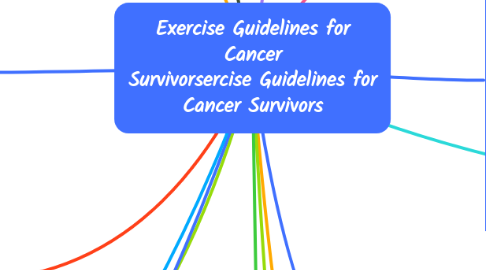
1. Combined moderate-intensity aerobic and resistance exercise performed two to three times per week for at least 12 wk results in improvements in health-related quality of life (HRQoL) both during and after treatment
2. LYMPHEDEMA
2.1. Insufficient evidence exists to conclude whether or not starting a resistance training program without supervised instruction is safe for women with or at risk for lymphedema after breast cancer
2.1.1. For resistance training, a general progressive program focused on large muscle groups
2.1.2. Two to three times per week, with the principle of “start low, progress slow” is safe when supervised by a fitness professional
3. PHYSICAL FUNCTION
3.1. It should be noted that these results are based on self-reported physical function, not objective measures where the evidence base on these outcomes remains immature and more challenging to aggregate due to the variation and limitations of assessment techniques.
3.1.1. Moderate-intensity aerobic training
3.1.2. Resistance training or combined aerobic plus resistance training
3.1.3. Three times weekly for 8 to 12 week
4. FATIGUE
4.1. Whether or not more exercise translates to less cancer-related fatigue remains unclear, though there is suggestive evidence that the reductions in fatigue are greater with exercise sessions longer than 30 min and programs longer than 12 wk compared with less exercise
4.1.1. Training programs that last at least 12 week
4.1.2. Moderate-intensity aerobic training three times per week
5. EXERCISE SAFETY AND TRAINING TOLERANCE
5.1. Safety of exercise training
5.1.1. The overall conclusion was that exercise is generally safe for cancer survivors and this has not changed based on the majority of studies conducted since that time.
5.2. Exercise tolerance
5.2.1. Research, to date, supports the potential of cancer survivors to respond positively to an exercise training stimulus by improving individual components of physical fitness.
5.2.1.1. As it is
5.2.1.1.1. Cardiorespiratory fitness (V˙O 2peak )
5.2.1.1.2. Muscular strength and endurance
5.2.1.1.3. Body composition
6. Exercise Testing
6.1. Ideally, cancer survivors should receive a comprehensive assessment of all components of health-related physical fitness
6.1.1. As it is
6.1.1.1. cardiorespiratory fitness, muscle strength and endurance, body composition, and flexibility
6.1.1.1.1. To individualize an exercise prescription.
7. PRESENTADO POR: LINA XIOMARA ARIAS VARGAS TATIANA CAMILA CERON MARIA JOSE CERTUCHE AMAYA ARY SANTIAGO FERNANDEZ
8. LIMITATIONS
8.1. The majority of available literature is still in the most common cancers, namely, early stage breast cancer and prostate cancers, which limits the ability to extrapolate their findings to other cancer types or advanced cancers.
8.1.1. Finally
8.1.1.1. A further understanding of dose response is limited by a paucity of trials that directly compare two or more levels of exercise training (eg, high-intensity vs low-intensity exercise) on cancer-related outcomes
9. ANXIETY
9.1. There is not sufficient evidence to determine whether or not there is a dose response relationship between exercise intensity and changes in anxiety.
9.1.1. A dose of moderate-intensity aerobic training
9.1.2. Three times per week for 12 week or twice weekly combined aerobic plus resistance training
9.1.3. In the 6 to 12 week can significantly reduce anxiety in cancer survivors during and after treatment
10. DEPRESSIVE
10.1. Improvements in depressive symptoms appear to be greater in supervised training programs
10.1.1. *Moderate-intensity aerobic
10.1.2. Three times per week
10.1.3. At least 12 week or twice weekly combined aerobic plus resistance training
10.1.4. Lasting 6 to 12 week can significantly reduce depressive symptoms in cancer survivors during and after treatment
11. In addition, there are other features that exercise helps in, however there is not much evidence to support these claims
11.1. Bone Health
11.2. Sleep
11.3. Insufficient Evidence
11.4. Cardiotoxicity
11.5. Cognitive function
11.6. Falls
11.7. Nausea
11.8. Pain
11.9. Sexual Function
11.10. Treatment tolerance
11.11. Chemotherapy-induced peripheral neuropathy
12. Other Exercise Modes
12.1. There is growing interest in the safety and efficacy of types of exercise that fall outside traditional modes of aerobic and resistance training.
12.1.1. There is evidence that activities such as yoga generate an improvement in sleep, depressive symptoms, anxiety/distress and cognitive changes related to cancer
13. Due to the growing number of cancer survivors it has created a need to address the unique health problems faced by survivors resulting from the disease, therefore in 2018, the ACSM International Multidisciplinary Roundtable on Physical Activity and Cancer Prevention and Control was convened to bring together an international group of exercise and rehabilitation professionals and organizations with the goal to update recommendations based on current evidence.
14. EFFECTS OF CANCER TREATMENT AND ADVERSE EFFECTS RELEVANT TO EXERCISE
14.1. To best evaluate a cancer survivor's exercise tolerance and prescribe a safe and effective exercise program, it is necessary for fitness professionals to know about the type and extent (ie, stage) of cancer a person has.
14.1.1. The treatment approach used will differ by type of cancer, stage of disease
14.1.1.1. Treatment modalities may include
14.1.1.1.1. Surgery
14.1.1.1.2. Radiation
15. IMPLEMENTING FITT PRESCRIPTIONS IN PRACTICE
15.1. Based on the current literature
15.1.1. An effective exercise prescription that most consistently addresses health-related outcomes experienced due to a cancer diagnosis and cancer treatment includes
15.1.1.1. Moderate-intensity aerobic training at least three times per week, for at least 30 min, for at least 8 to 12 wk.
15.1.2. Exercise programs that only prescribe resistance training are also efficacious at improving most health-related outcomes
15.2. Although a variety of professionals delivered supervised interventions in the research literature
15.2.1. Determining the type of professional that could maximize outcomes was beyond the scope of this article and the available evidence.
